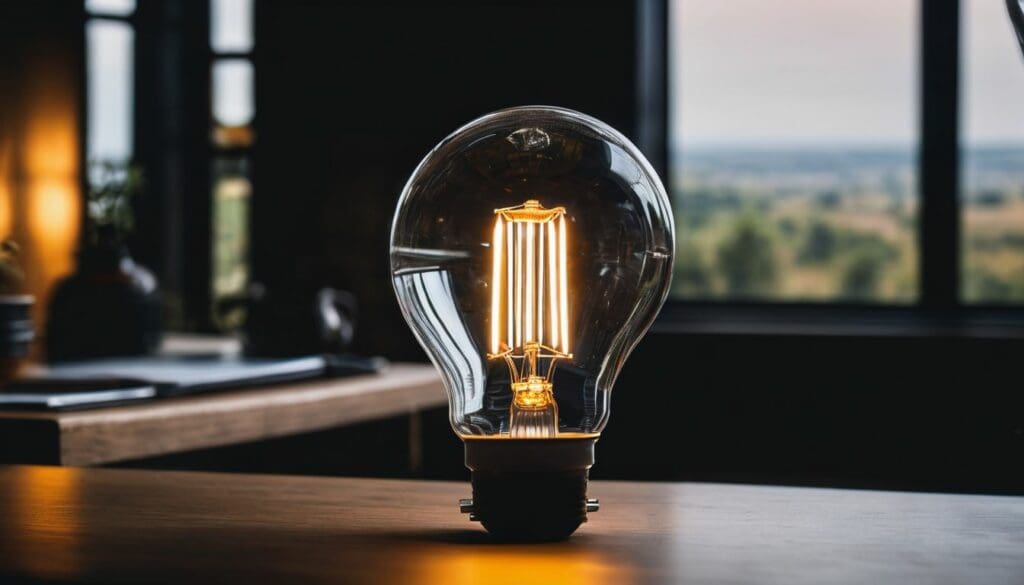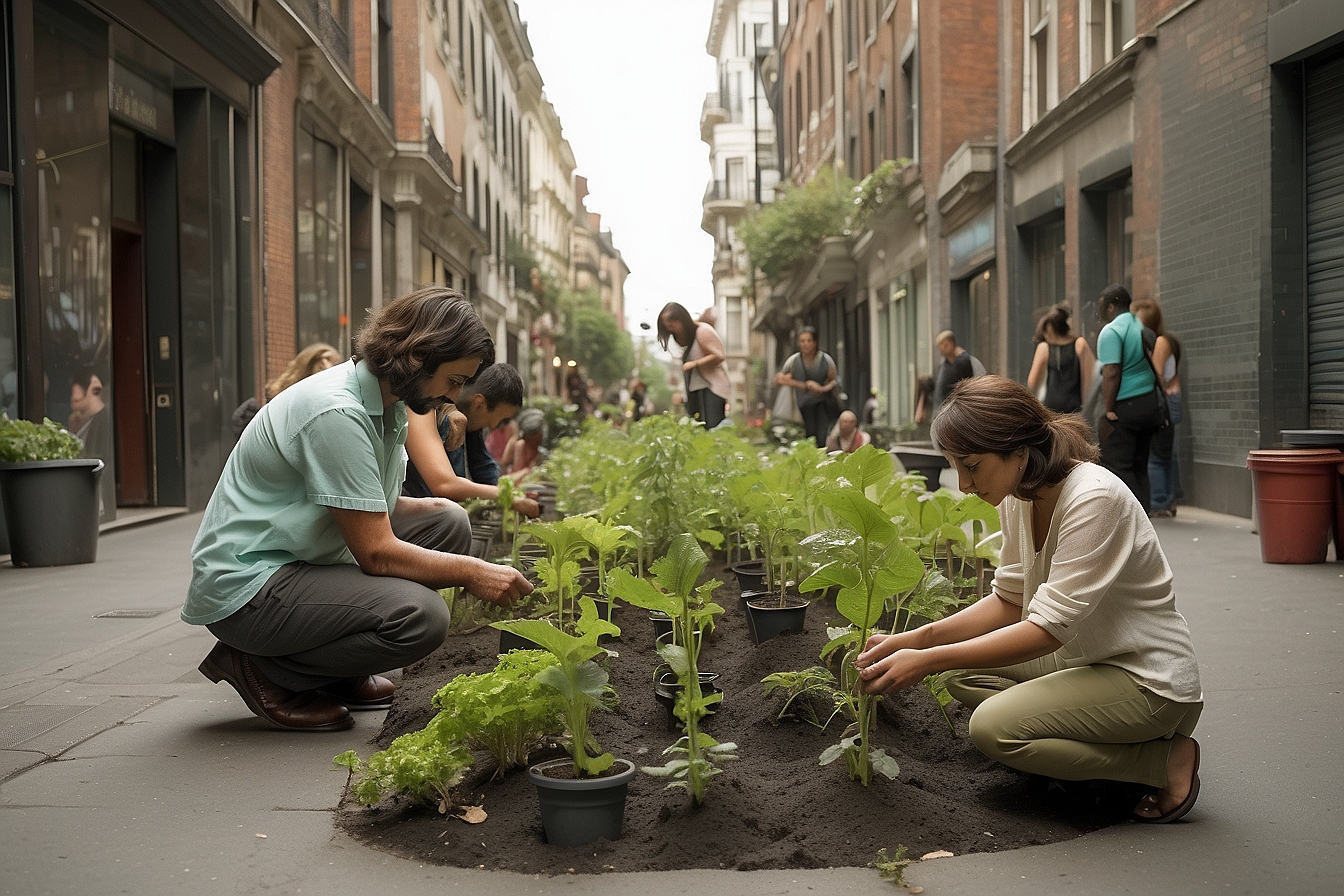We’ve all been taken aback by the sting of an electricity bill that’s soared beyond our expectations, haven’t we? Rest assured, you’re not alone in this quandary. I’ve delved into the nitty-gritty and it turns out that a significant 15% can be spared simply by making the switch to energy-efficient lighting.
This blog is chock-full of savvy suggestions to not just ease your purse strings but also tread more lightly on our precious planet. So keep reading for some truly illuminating advice!
Key Takeaways
- Energy – efficient bulbs like LEDs and CFLs can save up to 80% of the energy used by traditional incandescent bulbs. They also last much longer, with LEDs shining bright for up to 25 times longer, reducing both energy use and waste.
- By choosing lighting products with ENERGY STAR® certification, we contribute to a reduction in greenhouse gas emissions and support efforts towards environmental sustainability while lowering our own electricity bills.
- Smart home technologies work hand-in-hand with energy-saving bulbs by allowing us to control lights remotely, set schedules that align with our daily routines, and use sensors to ensure lights are only on when needed.
- Solar-powered lighting offers an eco-friendly alternative that uses renewable solar energy instead of grid electricity. This not only conserves energy but is also ideal for outdoor spaces without accessible power outlets.
- During holiday seasons or festive occasions, utilising efficient holiday lighting strategies such as using occupancy sensors ensures we celebrate responsibly without excessive energy consumption.
The Advantages of Energy-Efficient Lighting
Energy-efficient lighting has numerous benefits, including lower energy consumption, longer lifespan and a variety of bulb options such as LED and CFL. These bulbs not only save you money on your energy bills but are also better for the environment.
Types of energy-efficient bulbs (LED, CFL)
We know lighting is essential in our homes, and choosing the right bulbs can make a huge difference. Let’s explore the types of bulbs that not only brighten our spaces but also help us save energy and support the environment.
- LED Bulbs (Light Emitting Diodes):
- CFL Bulbs (Compact Fluorescent Lamps):
Longer lifespan
LED bulbs and CFLs not only save energy, but they also have a longer lifespan. LED lights can last up to 25 times longer than traditional incandescent bulbs, reducing the need for frequent replacements.
Similarly, CFLs can last up to 10 times longer than incandescent bulbs, providing long-term energy-efficient lighting solutions for homes and businesses. This extended lifespan reduces waste from discarded bulbs and contributes to a more sustainable environment.
Energy-efficient lighting options such as LED technology are designed with durability in mind, ensuring that fewer resources are used in manufacturing new bulbs over time. Additionally, the reduced frequency of replacement translates into lower maintenance costs and less hassle for homeowners or business owners.
Lower energy consumption
Energy-efficient lighting, such as LED and CFL bulbs, consumes less electricity than traditional incandescent bulbs. This results in reduced energy usage and lower utility bills while still providing the same level of brightness.
Using energy-saving technologies not only helps to cut down on our carbon footprint but also contributes to a more sustainable future for all.
LED lights are an excellent choice for reducing your energy consumption due to their low power requirements. Solar-powered lighting is another innovative solution that harnesses natural resources, further minimising electricity use.
By adopting these efficient lighting solutions, we can take significant strides towards a greener and more eco-friendly lifestyle.
How Energy-Efficient Lighting Can Help the Environment
Energy-efficient lighting can significantly reduce carbon emissions and help in decoupling economic growth from carbon emissions, contributing to a healthier environment for future generations.
Reduced carbon emissions
Energy-efficient lighting significantly reduces carbon emissions. LED bulbs, for instance, use up to 80% less energy than traditional incandescent lights, thereby cutting down on greenhouse gas emissions.
By switching to energy-efficient bulbs and fixtures, we can play a pivotal role in combating climate change and ensuring a greener future for generations to come.
Choosing LED or CFL bulbs over incandescent ones is an effective way to decrease carbon emissions and minimise our environmental impact. As we explore innovative lighting solutions, let’s consider the broader benefits of sustainable lighting technologies – not only for the environment but also for our own long-term energy savings.
Let’s delve into how we can harness these advancements through solar-powered lighting and smart home technologies while supporting a brighter future with reduced carbon footprints.
Decoupling economic growth and carbon emissions
Transitioning from reducing carbon emissions to decoupling economic growth and carbon emissions, it’s essential to understand that embracing energy-efficient lighting not only helps the environment but also supports sustainable economic development.
By utilising innovative technologies like LED lights and solar-powered lighting, we can significantly reduce our reliance on traditional energy sources while stimulating economic progress.
These solutions not only cut down on carbon emissions but also create opportunities for green jobs and a more robust economy.
Furthermore, investing in energy-efficient lighting technologies encourages research and development in the field, fostering innovation that drives economic growth without increasing carbon emissions.
Innovative Energy-Efficient Lighting Solutions
We explore cutting-edge solutions such as LED lights, solar-powered lighting, and smart home technologies that are revolutionising energy-efficient lighting. These innovations not only reduce energy consumption but also contribute to a greener and more sustainable future.
LED lights
LED lights are an excellent choice for energy-efficient lighting. They consume significantly less energy than traditional incandescent bulbs and have a longer lifespan, making them a sustainable option for environmentally conscious individuals.
LED lights also come in various colour temperatures, offering flexibility in creating the desired ambiance while reducing energy consumption.
Another advantage of LED lights is their durability, making them perfect for outdoor lighting solutions. With solar-powered options available, LED lights can provide eco-friendly illumination without relying on grid electricity.
Solar-powered lighting
After exploring the energy efficiency of LED lights, let’s delve into another innovative solution – solar-powered lighting. Solar-powered lighting harnesses the sun’s energy to provide sustainable and eco-friendly illumination for outdoor spaces.
By using photovoltaic cells to convert sunlight into electricity, these lights offer an environmentally friendly alternative to traditional grid-connected lighting. Additionally, solar-powered lighting systems often incorporate efficient LED bulbs, further enhancing their energy-saving capabilities and reducing reliance on non-renewable energy sources.
Furthermore, solar-powered lighting is a practical choice for outdoor areas where access to electrical outlets may be limited or impractical. These lights can range from decorative garden accents to practical security fixtures, offering versatile solutions for residential and commercial applications alike.
Smart home technologies
Smart home technologies provide an efficient way to manage energy use and lighting within the home. With features such as smart light bulbs, homeowners can remotely control the lights, set schedules, and adjust brightness levels using a smartphone or voice commands.
These energy-saving bulbs not only reduce electricity consumption but also come in various styles to suit different aesthetic preferences for eco-friendly home lighting.
In addition to smart light bulbs, motion sensors and automated dimmers are other examples of smart home technologies that help save energy by ensuring lights are only on when needed.
Ensuring Safe and Efficient Holiday Lighting
When it comes to holiday lighting, look for ENERGY STAR® certification and consider using occupancy sensors to ensure safe and efficient energy usage. Read on to discover more tips for environmentally friendly holiday lighting solutions.
Looking for ENERGY STAR® certification
When looking for lighting options, consider ENERGY STAR® certification. This mark indicates that the product meets strict energy efficiency guidelines set by the Environmental Protection Agency and the Department of Energy in the UK.
Choosing lights with this certification can help reduce energy consumption and lower utility costs while supporting environmental conservation efforts.
Focusing on ENERGY STAR® certified lighting not only benefits your individual energy usage but also contributes to larger environmental initiatives. By switching to these efficient bulbs, you are actively participating in reducing carbon emissions and promoting a greener future for our planet.
Using occupancy sensors
To enhance energy efficiency in our homes, we employ occupancy sensors. These devices detect movement and automatically turn off lights when no one is present, contributing to reduced electricity consumption.
Occupancy sensors are a simple yet effective solution for ensuring that lighting is only used when necessary, thus conserving energy and reducing utility costs.
Conclusion: The Importance of Energy-Efficient Lighting for a Sustainable Future
Choosing energy-efficient lighting isn’t just a personal choice; it’s a step towards environmental conservation. By opting for LED or CFL bulbs, we are reducing our carbon footprint and playing our part in promoting sustainability.
The innovative solutions available today, such as solar-powered and smart home technologies, make it easier than ever to embrace energy-efficient lighting for a brighter and greener future.
Our commitment to using safe, efficient holiday lighting ensures that we can enjoy the festive season without compromising on our environmental values.
FAQs
1. What is energy-efficient lighting?
Energy-efficient lighting includes technologies like low-energy bulbs and eco-friendly systems that reduce electricity use while providing light.
2. Can I save money with energy-efficient home lighting?
Yes, by switching to energy-saving bulbs and fixtures, you can lower your electrical bills significantly.
3. Are there outdoor lighting options that are energy efficient?
Certainly! You can choose from a variety of ecofriendly outdoor lighting options that are designed to be both effective and electrical efficiency-focused for gardens and pathways.
4. How do holiday lights fit into energy saving?
You can still celebrate with sparkle by using energy-efficient holiday lights which consume less power than traditional bulbs, making them green lighting alternatives for festive decorations.
5. Does energy-efficient mean less bright light in our homes?
Not at all! Energy-saving technologies have advanced so much that you can enjoy bright, high-quality light output from lamps while still being kind to the planet.





